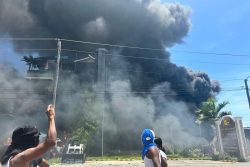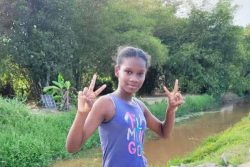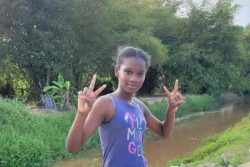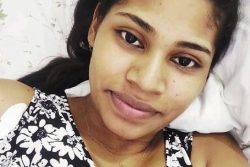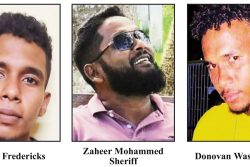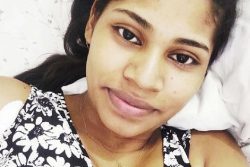The Prussian explorer Robert Schomburgk returned to England for a period of well-deserved rest following his rather extensive challenging and successful explorations of the main rivers of Guyana during the years 1835-1839.
Interestingly, even before his departure from Georgetown Schomburgk had written to the then Governor Henry Light stressing the urgency of fixing the boundary between Brazil and the colony of British Guiana. Such a plea was made against the background of his earlier experience in finding Brazilian soldiers in the Pirara district and of frequent incursions by Brazilians in the colony.
In 1840, Robert Schomburgk followed up with the production of a map of the colony and indicating its boundaries. As a consequence, Governor Light and the British Government were convinced that the highly sensitive boundary issue had to be settled. To this end Schomburgk was commissioned to lead an expedition to survey and determine the exact boundaries of the colony of British Guiana. This time around, he was “Her Britannic Majesty’s Commissioner for Surveying and Marking Out the Boundaries of British Guiana.”
Subsequently, Robert Schomburgk returned to the colony and made four different journeys into the interior of British Guiana between April 1841 and October, 1843 during which time he virtually traversed the entire boundary of the colony as it now stands. On this occasion he was accompanied by his brother, Richard Schomburgk, the famous botanist. They left their homeland and Germany, for the then British Guiana on October 29, 1840 and arrived in Georgetown in January, 1841.
The expedition comprising the Schomburgk brothers; Mr King, Superintendent of Rivers and Creeks in charge of the Barima and Waini rivers; Mr Eichlen, artist; Mr Glascott, assistant surveyor; Mr Peterson, first coxswain and Mr Cornelinsen, second coxswain, left Georgetown on April 19, 1841 and proceeded to the Waini river and through the Mora Passage to Kumaka and then to the Barima River. A navigational survey of the river was conducted and a boundary post was planted at its eastern point.
The party returned to Kumaka on May 20,after which the Amakura and Aruka rivers were carefully surveyed. While at the former they visited Assecura, a settlement comprising Warrau and Arawak Indians. A boundary post was planted to indicate the western limit of the country. Schomburgk and his expedition returned to Waini before proceeding up that river to its tributary, Barama and then overland to the Cuyuni River. They descended the river and the expedition eventually reached the junction of the three rivers, Essequibo, Mazaruni and Cuyuni and Bartica Grove on July 27, 1841 before returning to Georgetown two days later.
The party had spent approximately three and a half months exploring the rivers, Waini, Barima, Amakura, Aruka, Barama and Cuyuni while travelling over 700 miles. During this time Robert Schomburgk had acquired more accurate knowledge of the course of these rivers. Of added significance, he was able “to ascertain the limits of Dutch possessions and the zone from which all trace of Spanish influence was absent.”
Following a period of rest the members of the boundary expedition now comprising the Schomburgk brothers; Mr. Fryer, Schomburgk’s Secretary; Mr. E.A. Goodal, artist; Mr. Soreneng, interpreter; and a number of Indians as carriers and guides left Georgetown on the morning of December 23, 1841 for the specific purpose of defining and exploring the Brazilian frontier. They firstly travelled up the Essequibo to Tampa and then to Bartica where they were joined by Rev Thomas Gould. The party proceeded to ascent the Essequibo and the Rupununi rivers to Pirara. While there, British troops arrived to assert British rights to the territory and to prevent further incursions of the area by Brazilians.
Utilising Pirara as his base, Robert Schomburgk proceeded to explore the Takutu river to as far as the junction of the Pirara and Ireng Rivers. Boundary markers were erected at the confluence of the Takatu and Ireng Rivers and the right bank of the former was formally claimed as the south-western boundary of the colony. Markers were erected at various points along the whole course of the river in an attempt to help protect the Indians by identifying them as “Her Majesty’s subjects.”
The expedition returned to Pirara and the explorer then traced the Cotinga or Kurumu river to its source at Mount Roraima. He became the first European to accomplish this feat. Thereafter he discovered the sources of the Cuyuni and travelled downwards to the mouth of the Acarabisi. The low level of water of the Takutu forced the party to cross savannah and the Kamuku Mountains on their way to Pirara village which was reached on May 22, 1842.
Robert Schomburgk sent the larger part of his expedition to Pirara while the rest travelled between the watershed of the Orinoco on one side and the Mazaruni and Cuyuni rivers on the other until the Wenamu River, 220 miles up the Cuyuni, was reached. The party subsequently travelled downwards to the marker Schomburgk had previously erected when he surveyed that part of the colony from Barima Point. He had thus surveyed “the whole line from the sources of the Takutu to Point Barima on the Atlantic Ocean.” The expedition eventually returned to Georgetown in January, 1843.
After a month’s rest Robert Schomburgk decided to complete his commission with a survey of the boundary with neighbouring Dutch Guiana (now independent Suriname). It was his view that “In order to bring the survey which has been entrusted to me to final and satisfactory close, it remains now to trace the country, between the sources of the River Takutu and those of the River Corentyne; and to descend the latter to its embouchure into the Atlantic.”
The expedition initially visited Pirara and from there ventured southwards with a view of conducting a more thorough exploration of the Upper Essequibo and the watershed between the Essequibo and the Amazon Rivers. Leaving the village of Taruna Indians on the Upper Essequibo the party proceeded to trace the Onoro or Onororo River, a tributary of the Essequibo, 265 miles from the mouth of the Rupununi before eventually returning to Pirara.
Robert Schomburgk decided to leave the Rupununi and to traverse the Carawaini Mountains in its quest to the Upper Corentyne. He found the Cutari River with its branch the Curuwuini that flowed into the Corentyne. He identified Cutari as the source of the Corentyne and proceeded to map the river as constituting the eastern boundary of the colony of British Guiana. He then descended the Corentyne beyond his 1836 venture and arrived at Tomatai settlement.
Robert Schomburgk eventually arrived in Georgetown on October 12, 1843 with the objectives of his expedition fully realized. His brother, Richard subsequently explored the Pomeroon, Moruca and Demerara rivers. The explorer spent some time in Georgetown completing his maps and his accounts of his travels. He then departed British Guiana on May 19, 1844 and arrived in England on June 25 of the same year.
Indeed Robert Schomburgk had made a sterling contributing to the colony’s History, Geography and Botany. He traced many of Guyana’s rivers to their sources, he demarcated the boundaries and demonstrated his genuine concern for the indigenous people. As to the importance of the colony, Robert Schomburgk was very optimistic when he said, “Guiana bids fair ere long to become a focus of colonization and with her fertility, her facilities of water communication, she may yet vie with the favoured provinces of the eastern empire, and become as Sir Walter Raleigh predicted the El Dorado of Great Britain’s possessions in the West.”
Among his numerous other initiatives in the nineteenth century are the establishment of the Royal Agricultural and Commercial Society, a Natural History Museum, the Botanical Gardens, an Observatory and the Astronomical and Meteorological Society.
As a result of the invaluable contributio
n of this very remarkable, energetic, visionary and courageous explorer he was very deservedly knighted in 1845 and appointed General Consul and Representative of Business in the Dominican Republic, a position he held for nine years.
In 1857 he was made British Consul-General for Bangkok. Due to ill-health he returned to Germany in 1864 and died a year later.The name Robert Schomburgk is certain to live on for generations to come in Guyana’s history.



